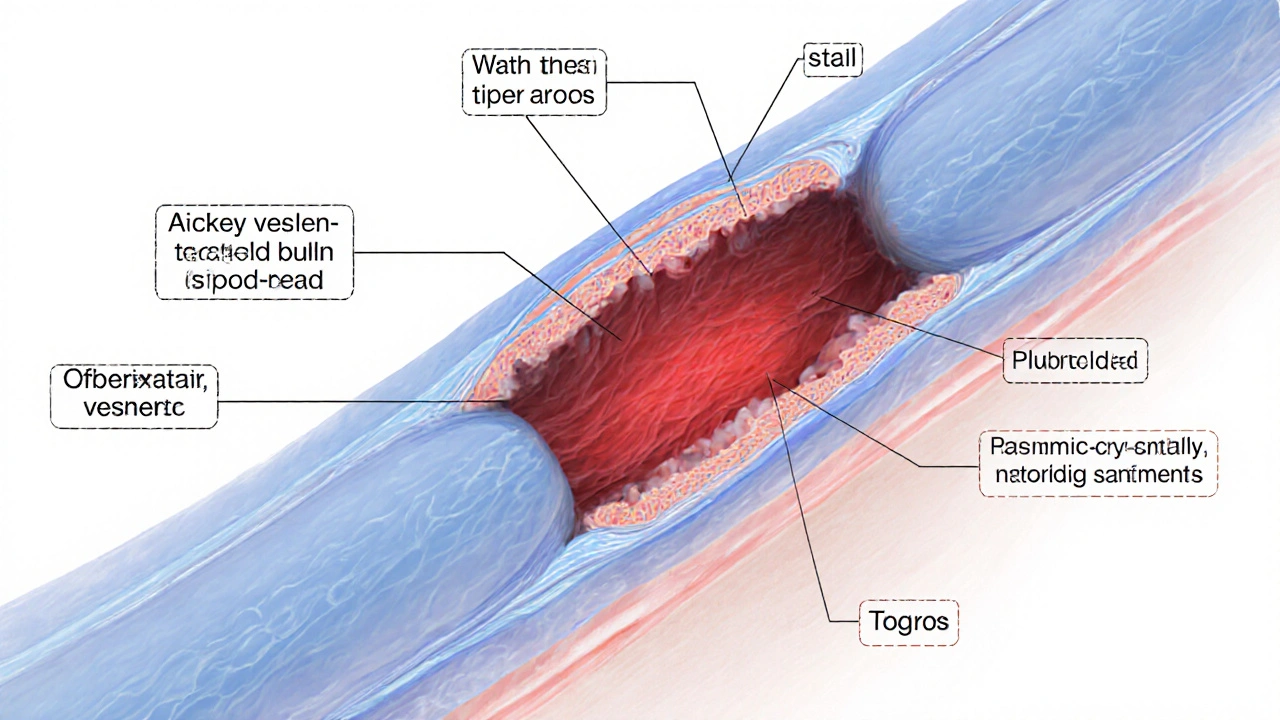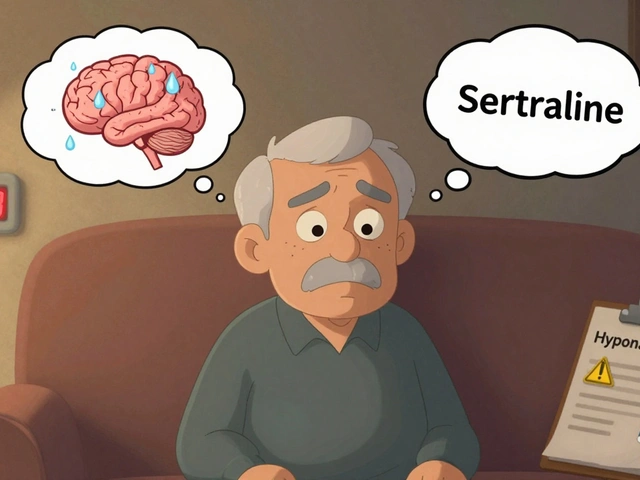Ischemia Explained: Causes, Symptoms & Treatment Options

Ischemia Symptom Checker
Select the organ system that matches your symptoms to identify potential ischemia indicators.
Heart (Coronary)
Chest pain, shortness of breath, sweating, nausea
Brain (Cerebral)
Sudden weakness, speech issues, vision loss, balance problems
Limbs (Peripheral)
Leg pain while walking, cold feet, non-healing sores
Potential Ischemia Symptoms
Important Note
This tool helps identify potential symptoms. Always consult a healthcare professional for accurate diagnosis and treatment recommendations.
Emergency Care: Seek immediate medical attention for sudden, severe chest pain or stroke-like symptoms.
When blood can’t deliver enough oxygen to tissues, the resulting damage can be sudden, scary, and often preventable. That shortage is called ischemia, and it shows up in everything from a heart attack to a leg that hurts while walking. Understanding why it happens, how to spot it early, and what you can actually do about it can mean the difference between a quick recovery and a chronic health issue.
Key Takeaways
- Ischemia is tissue damage caused by reduced blood flow and oxygen supply.
- Common causes include atherosclerosis, blood clots, and severe low blood pressure.
- Symptoms vary by organ: chest pain for the heart, sudden weakness for the brain, and cramping for limbs.
- Diagnosis relies on imaging (angiography, MRI, CT) and functional tests (stress tests, ankle‑brachial index).
- Treatment ranges from medication and lifestyle changes to minimally invasive procedures like angioplasty and major surgeries such as bypass grafting.
What Is Ischemia?
Ischemia is a medical condition where blood flow to a part of the body is insufficient to meet its metabolic needs, leading to oxygen deprivation and potential tissue injury. It can affect any organ, but the heart, brain, and peripheral limbs are the most common sites.
Primary Causes of Ischemia
Most ischemic events trace back to a blockage or narrowing of the arteries that supply the affected tissue.
- Atherosclerosis is the buildup of fatty plaques inside arterial walls, gradually narrowing the lumen and restricting flow.
- Blood clot (thrombus) can form on a plaque surface or travel from elsewhere, abruptly occluding an artery.
- Vasospasm is an abrupt constriction of a blood vessel, often triggered by drugs or electrical activity.
- Severe hypotension reduces overall perfusion pressure, making even modest blockages critical.
Underlying risk factors that accelerate these mechanisms include smoking, hypertension, diabetes, high cholesterol, and a sedentary lifestyle.

How Ischemia Shows Up: Symptoms by Organ
Because each organ has unique functions, the warning signs differ.
- Heart (coronary ischemia): crushing chest pain, shortness of breath, sweating, and nausea-often termed angina.
- Brain (cerebral ischemia): sudden weakness or numbness on one side, speech difficulty, vision loss, or loss of balance-classic stroke signs.
- Limbs (peripheral ischemia): aching or cramping while walking (claudication), cold feet, pale skin, or non‑healing wounds.
When symptoms appear suddenly and intensify, emergency care is crucial.
Diagnosing Ischemia
Accurate diagnosis blends clinical evaluation with imaging and functional testing.
- Angiography provides a detailed view of arterial blockages using contrast dye and X‑ray.
- Magnetic Resonance Imaging (MRI) can detect tissue damage and blood flow deficits without ionizing radiation.
- CT Scan (especially CT angiography) quickly maps vascular anatomy in emergencies.
- Stress tests (exercise or pharmacologic) reveal how the heart responds when demand outpaces supply.
- The Ankle‑Brachial Index (ABI) measures blood pressure ratios between the ankle and arm, screening for peripheral artery disease.
Treatment Options: From Pills to Surgery
Therapy aims to restore blood flow, protect at‑risk tissue, and prevent recurrence.
Medication
- Antiplatelet agents (e.g., aspirin, clopidogrel) reduce clot formation.
- Statins lower cholesterol, stabilizing plaques.
- Beta‑blockers and ACE inhibitors manage blood pressure and heart workload.
Minimally Invasive Procedures
- Angioplasty involves inflating a tiny balloon inside the narrowed artery to widen it, often followed by a stent.
- Catheter‑directed thrombolysis dissolves clots using medication delivered straight to the blockage.
Major Surgical Options
- Coronary artery bypass grafting (CABG) creates new routes for blood using vessels from the leg or chest.
- Endarterectomy surgically removes plaque from carotid arteries to prevent stroke.
Lifestyle & Risk‑Factor Management
- Quit smoking; nicotine accelerates plaque growth.
- Adopt a Mediterranean‑style diet rich in fruits, vegetables, whole grains, and omega‑3 fats.
- Engage in moderate aerobic activity (150 minutes/week) to improve endothelial function.
- Control blood pressure and blood sugar through regular monitoring and medication adherence.

Comparing Treatment Modalities
| Option | Invasiveness | Typical Recovery Time | Best Used For |
|---|---|---|---|
| Medication | Non‑invasive | Immediate (no downtime) | Stable plaques, secondary prevention |
| Angioplasty + Stent | Minimally invasive | 1-2 days hospital stay; full activity in 1 week | Acute coronary or peripheral blockages |
| Bypass Surgery | Highly invasive | 5-7 days ICU; 4-6 weeks before full activity | Complex multi‑vessel disease, diabetics |
Prevention Checklist
- Check blood pressure at least twice a year.
- Screen cholesterol levels every 4-6 years (more often if you have risk factors).
- Maintain a waist circumference below 40inches for men, 35inches for women.
- Schedule a foot exam if you have diabetes or peripheral symptoms.
- Ask your doctor about a low‑dose aspirin regimen if you’re over 50 and have no bleeding risk.
Frequently Asked Questions
What is the difference between ischemia and infarction?
Ischemia is reduced blood flow that may be reversible. If the shortage lasts long enough, the tissue undergoes irreversible death, called an infarction.
Can lifestyle changes alone treat ischemia?
Mild or early‑stage ischemia can improve markedly with diet, exercise, and risk‑factor control, but many patients still need medication or procedures to fully restore flow.
How quickly should I seek emergency care for chest pain?
Treat any new, crushing chest pain as an emergency. Call ambulance immediately; earlier treatment dramatically improves outcomes.
Is angioplasty always followed by a stent?
Most cardiologists place a stent to keep the artery open, but in some peripheral cases a plain balloon angioplasty may be sufficient.
What are the risks of bypass surgery?
Risks include infection, bleeding, stroke, and heart rhythm problems. However, for extensive blockages the long‑term survival benefit often outweighs these risks.
Understanding the why, what, and how of ischemia empowers you to act before a minor blockage turns into a major health crisis. Whether you’re a patient, a family member, or simply curious about your own risk, the steps above give you a clear roadmap from detection to treatment.
10 Comments
Hannah Tran
Hey everyone, let’s dive deep into the hemodynamic cascade that underlies ischemic events.
When arterial lumen diameter is reduced by >70%, myocardial oxygen demand outpaces supply, precipitating cellular hypoxia.
This oxygen deficit triggers anaerobic glycolysis, accumulation of lactate, and subsequent intracellular acidosis.
The resulting oxidative stress impairs mitochondrial oxidative phosphorylation, compromising ATP generation.
Endothelial dysfunction follows, characterized by reduced nitric oxide bioavailability and increased endothelin‑1 expression.
Platelet activation then ensues, releasing thromboxane A2 and fostering microthrombus formation at the plaque interface.
Clinically, patients may present with exertional angina that resolves with nitrates, reflecting reversible ischemia.
However, if the occlusion becomes total, necrotic infarction sets in within 20–30 minutes of sustained ischemia.
Diagnostic work‑up should incorporate coronary angiography to visualize stenotic lesions and quantify fractional flow reserve.
Non‑invasive stress testing, such as a treadmill ECG, can also stratify risk by uncovering ischemic thresholds.
Therapeutically, antiplatelet agents like aspirin inhibit cyclooxygenase‑1, reducing thromboxane synthesis.
Statins stabilize atheromatous plaques by lowering LDL cholesterol and exerting pleiotropic anti‑inflammatory effects.
For acute revascularization, percutaneous coronary intervention with balloon angioplasty and drug‑eluting stent placement restores luminal patency.
In multivessel disease, coronary artery bypass grafting provides durable conduit flow using internal mammary artery grafts.
Lifestyle modifications, including Mediterranean diet adherence, aerobic exercise, and smoking cessation, dramatically lower recurrence risk.
So, to sum up, early recognition of ischemic symptomatology and prompt implementation of these multimodal strategies can dramatically improve prognostic outcomes.
Crystle Imrie
Wow, another endless lecture on diet when a single bad night can ruin everything.
Shelby Rock
Life’s a tapestry, woven with threads of pain and relief, and ischemia is just one knot in the fabric.
We often chase the miracle cure, forgetting that the body’s own homeostasis is a fragile equilibrium.
Ever considered that the very act of labeling a symptom might amplify its perception, a sort of psychosomatic echo?
Yet, the cold hard truth remains: reduced perfusion does damage tissue, no matter how we spin it.
So, maybe the answer lies not in the lab, but in listening to the silent whispers of our own cells.
Dhananjay Sampath
Your overview is impressively comprehensive, Hannah, yet I must point out that patient compliance, especially regarding statin adherence, remains a critical bottleneck, and without it, even the most advanced revascularization techniques may falter.
Additionally, we should not overlook socioeconomic barriers that often dictate therapeutic success.
kunal ember
While the philosophical musings on ischemia’s metaphorical significance are intriguing, the clinical reality demands a methodical approach.
The diagnostic algorithm typically begins with a thorough history and physical examination, followed by non‑invasive imaging to assess perfusion deficits.
If the initial work‑up suggests significant arterial narrowing, stress testing can quantify functional impairment under physiologic load.
Subsequent invasive coronary angiography provides the definitive anatomical roadmap, enabling precise lesion characterization.
Therapeutic decisions then hinge on lesion severity, symptom burden, and patient comorbidities, balancing medical therapy against interventional options.
Medical management prioritizes antiplatelet agents, lipid‑lowering statins, and antihypertensive regimens to stabilize plaque progression.
When symptoms persist despite optimal pharmacotherapy, percutaneous interventions such as balloon angioplasty with drug‑eluting stents become viable.
In cases of extensive multivessel disease, coronary artery bypass grafting offers superior long‑term patency, albeit with higher upfront risk.
Ultimately, a shared decision‑making model that respects patient values while integrating evidence‑based guidelines yields the best outcomes.
Kelly Aparecida Bhering da Silva
The mainstream narrative about ischemia treatment is nothing more than a carefully crafted agenda pushed by Big Pharma and shadowy governmental health agencies.
They flood us with glossy brochures about statins and stents, all to line their pockets while keeping the public dependent on endless medication cycles.
What they don’t tell you is that many of these so‑called 'life‑saving' procedures have been commercialized beyond necessity, inflating costs without proportional benefit.
Historical data shows that lifestyle modifications, which require no patent, can reduce incidence by up to 40%, yet this truth is conveniently buried beneath sponsored research.
Don’t be fooled by the glossy CT images; they’re just marketing tools wielded by those who profit from surgery.
Independent researchers have flagged conflicts of interest in numerous guideline committees, proving the system is compromised.
If you truly care about your health, demand transparency, question the authority, and seek out unbiased information.
Remember, your body is your sovereign domain, not a test subject for corporate trials.
The truth is out there, and it’s time to reclaim control over our own vascular destiny.
So before you sign up for the next stent, ask who stands to gain, and consider that the real cure may lie in community empowerment, not pharmaceutical dependency.
In the end, vigilance is the only safeguard against being manipulated by the health‑industrial complex.
Caley Ross
I hear the frustration, but personal health decisions still need solid evidence, not just anger.
At the end of the day, each of us must weigh the data and decide what feels right.
Bobby Hartono
Understanding ischemia is like piecin together a massive puzzle where each piece represents a different physiological factor.
The human body, in its complexity, can sometimes throw us curveballs that no textbook can fully capture.
When you read about angioplasty, think of it as a temporary fix, like patching a leaky pipe without checking the water pressure upstream.
Many patients definately underestimate the power of simple lifestyle changes, believing that a single workout can reverse years of damage.
But research beleive that consistent habits over months, not weeks, are what truly shift the trajectory.
Don’t let flashy marketing videos convince you that every chest pain needs a stent; sometimes it’s just acid reflux or anxiety.
Education, community support, and honest conversations are the real tools that help people navigate these health choices.
So keep asking questions, stay skeptical, and share reliable info whenever you can.
George Frengos
Your emphasis on community education resonates deeply, and it aligns with evidence that patient empowerment improves outcomes.
Providing clear, culturally sensitive resources can bridge gaps in understanding and foster adherence.
Thank you for highlighting the importance of balanced information, which is essential for informed decision‑making.
Jonathan S
Indeed, the synergy between professional guidance and grassroots education creates a powerful framework for tackling ischemia, and we must celebrate that collaborative spirit 😊.
When clinicians speak the language of the community, trust builds, leading to higher rates of preventive screening and earlier intervention 👍.
It’s also critical to address misinformation head‑on, debunking myths with solid data while remaining compassionate to those who may feel overwhelmed 😔.
Integrating technology, such as tele‑health platforms, can extend reach to remote populations, ensuring equity in care delivery 🌍.
Moreover, continuous feedback loops between patients and providers refine treatment protocols, making them more responsive to real‑world challenges 🛠️.
Let’s continue to champion open dialogue, celebrate successes, and learn from setbacks, because progress is a collective journey 🚀.
Together, we can transform the narrative around ischemia from one of fear to one of empowerment and hope 🌟.






Write a comment